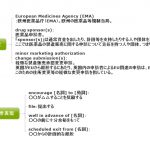
| 番号 | 用語(日本語)
参考記事 |
定義・解説(日本語) | 用語(英語)
引用元 |
定義・解説(英語) |
| 91 | 主要文献及び文献請求先 | 各項目の裏付けとなる文献を記載。文献請求先住所・連絡先を記載。添付文書記載事項 | references and request and contact info | Describes literature supporting each section. Also, the address and contact information where a request for literature should be sent to is included. Package insert section |
| 92 | 医療用医薬品 | 広い意味では一般医薬品と対となる用語。原則として医師の処方箋が必要な医薬品。処方箋医薬品というカテゴリーがあるが、一部処方箋医薬品でない医療用医薬品が存在するので、処方箋医薬品より範囲が広い。 | ethical drugs
|
In a broad sense, ethical drugs should be remembered with over the counter drugs. Basically ethical drugs require a doctor's prescription to be purchased. Ethical drugs is a broader category than prescription drugs because there are drugs that are ethical drugs but not prescription drugs. |
| 93 | 一般用医薬品 | 薬局等で処方箋なしで買える医薬品。通称OTC | over the counter drug(s), OTC(s)
|
Drugs that are available at drug stores without prescriptions. So called OTCs |
| 94 | 医薬品の適正使用 | 患者にあった適切な薬剤、剤形、用量が判断されたうえで、医薬品が処方・調剤され、患者は医薬品の使い方について正しい情報を受け取る。さらに、正しい方法での医薬品の使用後に効果と副作用がフィードバックされるプロセスのこと。 | proper use of drugs | It is a process that a drug is used appropriately: right medications with the optimal dosage form and dose are prescribed and dispensed based on the patient's condition. The patient receives correct information about how to use the medication. After use, feedback of the effects and side effects with correct medication use is provided. |
| 95 | 医薬品の適応内使用 | 医薬品が承認されている効能・効果、用法・用量に基づいた使用のこと。 | on-label use of drugs | Drug use based on approved indications, and dosage and administration |
| 96 | 医薬品の適応外使用 | 医薬品が承認されている効能・効果、用法・用量以外での使用のこと。 | off-label use of drugs | Drug use not based on approved indications, and dosage and administration |
| 97 | 中央社会保険医療協議会 | 通称「中医協」。薬価や診療報酬をなど医療保険関係のトピックを議論する厚労大臣の諮問機関 | Central Social Insurance and Medical Council (Chuikyo) | So called Chuikyo. An advisory body to the Minister of Health, Labour, and Welfare where health insurance-related topics such as drug pricing and medical fee reimbursement are discussed |
| 98 | 日本薬局方(日局) | 医薬品の品質規格基準書。厚生労働大臣が薬事・食品衛生審議会の意見を聞いて定める。 | Japanese Pharmacopoeia (JP) | Collection of drug quality standards, which is established by the Minister of Health, Labour, and Welfare with input from the Pharmaceutical Affairs and Food Sanitation Council |
| 99 | 安全対策業務 | PMDAの3大業務の内の一つ。医薬品等の市販後の安全性情報を収集・管理する。 | safety measures | One of the PMDA's 3 major responsibilities: collecting and managing postmarket safety information of drugs and other products |
| 100 | 健康被害救済業務 | PMDAの3大業務の内の一つ。医薬品を適正に使用したにも関わらず発生した健康被害の救済を図る。 | relief services for adverse health effects | One of the PMDA's 3 major responsibilities: providing relief to injury incidence in spite of proper drug use |
| 番号 | 用語(日本語)
参考記事 |
定義・解説(日本語) | 用語(英語)
引用元 |
定義・解説(英語) |
| 101 | 資料概要 | 資料の概要であるが、古くはイロハ申請での概要。国際的に標準化された様式であるCTDが導入されたあとは、CTD Module 2を指す。 | data summary (Gaiyo)
|
Overview of the materials. Traditionally known as "Gaiyo" for the "Iroha" submission. The data summary refers to CTD Module 2 after the internationally standardized CTD format was adopted. |
| 102 | (米国)食品医薬品局 | 米国の医薬品等規制当局 | FDA | Regulatory authority that regulates drugs and other products in the United States |
| 103 | 欧州医薬品庁 | 欧州の医薬品等規制当局 | EMA
|
Regulatory authority that regulates drugs and other products in the European Union |
| 104 | 医学文献 | 専門家の査読を受けて専門雑誌に投稿された医学文献 | medical literature | Medical articles published to specialty journals after peer review |
| 105 | 施設選定 | 臨床試験を行う施設の選定。1施設あたり何名の被験者を組み入れられるか等を考慮して決定される。 | site selection | Choosing sites where a clinical trial is conducted. Sites are determined based on the assumption of how many subjects can be enrolled at each site. |
| 106 | 治験の実施可能性
|
臨床試験が実施可能かどうかの評価。目標症例数と1施設あたりの予想被験者数等を考慮して評価する。 | feasibility | Evaluation of whether a clinical trial can be conducted, based on the target number of subjects, expected number of subjects per site, and other factors |
| 107 | 治験施設審査委員会 | 治験の実施が倫理的・科学的に妥当かを第3者の立場から判断する機関。治験実施者と直接の利害関係を有さないメンバーや専門家でないメンバーが必ず必要。 | institutional review board (IRB) | Advisory body that judges whether conducting a clinical trial is ethically and scientifically reasonable from a third person perspective. A non-expert member and member without any conflicts of interest must be included. |
| 108 | (被験者の治験参加への)同意 | いわゆるインフォームドコンセント。被験者は文書で治験のメリット・デメリット等、治験に参加しなくてもよく、参加してもいつでもやめることができる旨の説明を受けたうえで、参加する場合には文書で同意を表明する。 | consent | So called informed consent. A written consent should be obtained from the subject who is willing to join the study after written information about advantages and disadvantages of joining the study, and the choice of not joining or withdrawing from the study at any time. |
| 109 | スクリーニング | 治験は均一な対象集団で評価するために、その基準を満たす被験者を参加させる選択基準と、その基準を満たす被験者を参加させない除外基準がある。スクリーニングは選択・除外基準にあう被験者を選別するステップ | screening | To evaluate a homogeneous study population in a clinical trial, eligibility criteria are set: inclusion criteria for subjects meeting the criteria to be included and exclusion criteria for subjects meeting the criteria to be excluded. Screening is a step of choosing subjects based on the eligibility criteria. |
| 110 | 治験薬 | 治験で主に評価される医薬品を指す。 | study drug(s),
investigational drug(s), investigational product(s) |
Refers to the drug mainly evaluated in a clinical trial |
| 番号 | 用語(日本語)
参考記事 |
定義・解説(日本語) | 用語(英語)
引用元 |
定義・解説(英語) |
| 111 | 重大な副作用 | その医薬品で特に注意を要する副作用。一言でいえば、命にかかわる副作用である。 | clinically significant adverse reaction(s) | Adverse reactions that require special attention for the drug. In other words, adverse reactions concerning life or death |
| 112 | 初回治験届 | 通常その医薬品に関して、PMDA/MHLWに初めて提出される治験計画届を指す。 | initial CTN | Normally refers to the very first clinical trial protocol notification submitted to the PMDA/MHLW for the drug |
| 113 | 当該治験を行うことを妥当と判断した妥当性文書 | 通称「妥当性文書」。それまでに行った試験結果から、その医薬品の治験を行うことが科学的に妥当であると判断した治験実施者の見解を示した文書。 | rationale justifying the conduct of the clinical study | So called rationale document. It is a document that shows the sponsor's opinion scientifically justifying the conduct of the clinical trial based on studies already conducted. |
| 114 | 治験実施計画書 | いわゆるプロトコール。治験の対象被験者、用法・用量、評価項目等、どのように試験を行い医薬品を評価するか記載されている。 | clinical study protocol(s) | So called protocol. The document specifying how to conduct a study and evaluate the study drug including target patients, dosage and administration, endpoints |
| 115 | インフォームドコンセントに用いられる同意文書 | 同意説明に用いられる文書はwritten explanationsである。 | informed consent form(s) | Document used to explain about the clinical trial is called written explanations |
| 116 | 症例報告書 | 各被験者についてプロトコールに記載のある評価項目を記載する様式 | case report form(s), CRF(s) | Format to describe the evaluation items specified in the protocol for each subject |
| 117 | 治験薬概要書 | それまでに行われた試験の結果を基に治験薬の特性をまとめた資料。治験施設へ提供される治験薬に関する重要な資料 | investigator's brochure(s) | Document that summarizes the study drug's characteristics based on the studies conducted so far. An important document provided to study sites about the study drug |
| 118 | GCP | 別名「医薬品の臨床試験の実施の基準に関する省令」。臨床試験を実施する際に順守が必要な基準。信頼性の基準でもある。 | Good Clinical Practice (GCP) | Also called the Ministerial Ordinance on Good Clinical Practice for Drugs. It is a required compliance standard for conducting clinical trials, as well as data reliability criteria. |
| 119 | 省令 | 法律には法、政令、省令、通知の4レベルがある。省令は、各省により制定される法律。この文脈では厚生労働省による省令であり、通常、厚生労働省規則や施行令と呼ばれる。 | Ministerial Ordinance | Japanese laws and regulations consist of 4 levels: laws, government ordinances, ministerial ordinances, notifications. Ministerial ordinances are laws that are established by the Ministry of Health, Labour, and Welfare, and normally called MHLW regulations or enforcement regulations. |
| 120 | データの信頼性を担保する基準 | いわゆる信頼性の基準。正確性、網羅性、記録がキーワードである。 | criteria for ensuring data reliability | So called data reliability criteria. Correctness, completeness, and record are the key words. |










